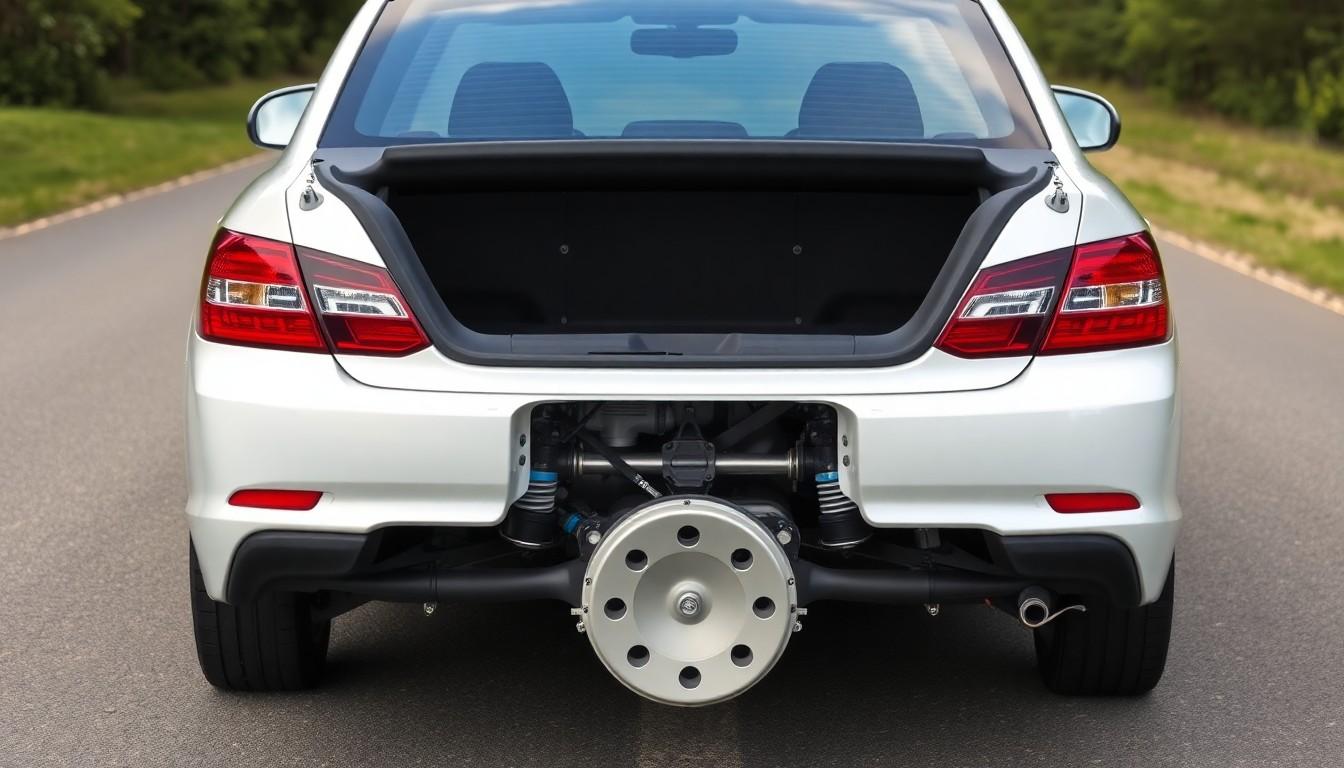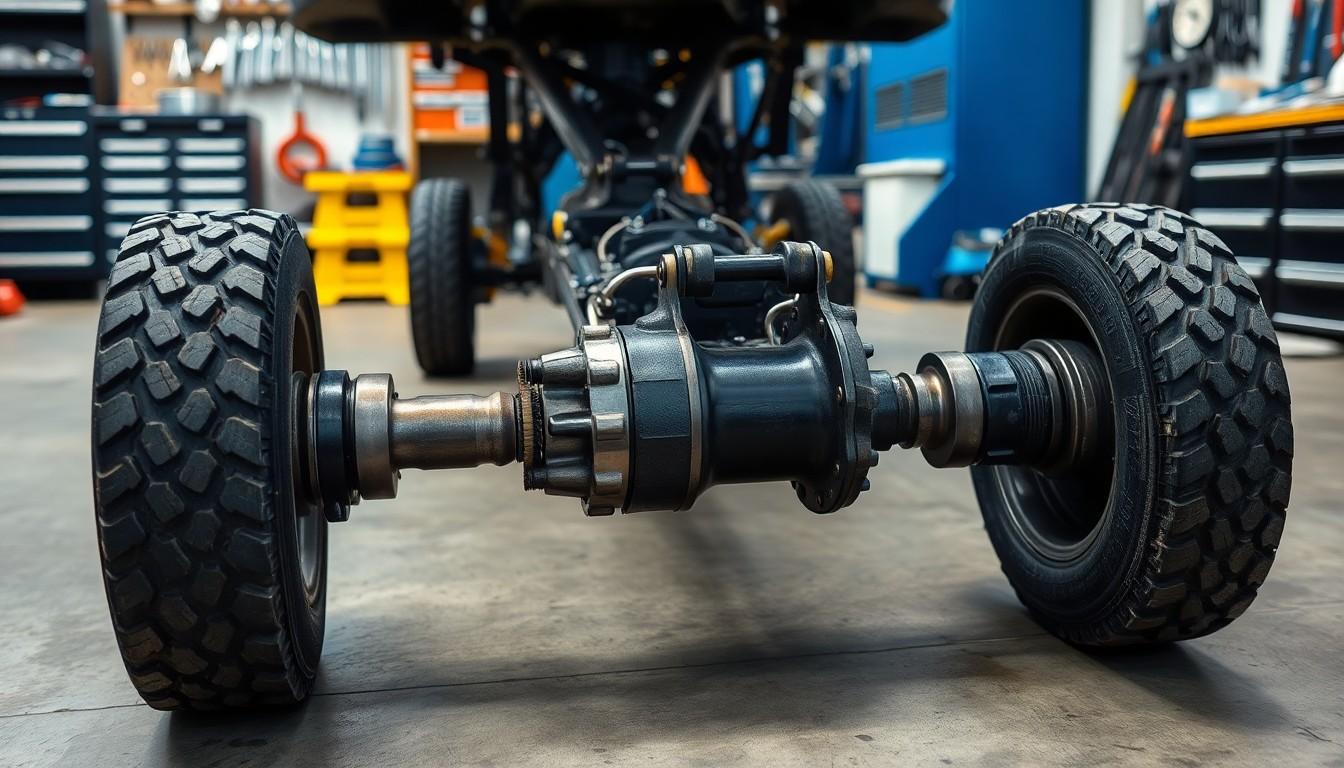Ever wondered about those essential components that keep your car rolling smoothly down the road? While we often focus on engines and transmissions, the humble axle deserves some spotlight too. These crucial mechanical parts connect your wheels and support your vehicle’s weight while allowing rotational movement.
Most passenger vehicles we encounter daily have two axles – one connecting the front wheels and another for the rear. But, the answer isn’t always that straightforward. Vehicle type, size, and purpose all influence axle count and configuration. In this comprehensive guide, we’ll explore everything you need to know about car axles, from standard configurations to specialized variations found in larger vehicles.
Understanding Car Axles and Their Function
Car axles form the critical backbone of a vehicle’s drivetrain system, connecting wheels on opposite sides while supporting the car’s weight. These robust shafts transfer power from the transmission to the wheels, enabling smooth rotational movement and forward propulsion.
Axles don’t merely connect wheels—they serve multiple essential functions simultaneously:
- Weight support: Axles bear the entire weight of the vehicle and its contents
- Power transfer: They transmit rotational force from the engine to the wheels
- Directional control: Front axles work with the steering system to change direction
- Stability provision: Axles maintain proper wheel alignment during driving
Modern passenger vehicles typically feature two main types of axles. Front axles are designed to absorb shocks from uneven road surfaces while facilitating steering. Rear axles focus primarily on power delivery and weight distribution, particularly in rear-wheel-drive configurations.
Each axle assembly includes several components working together. The axle shaft itself connects to CV joints or universal joints that allow for flexibility during suspension movement and steering. Differential gears mounted within the axle housing enable wheels to rotate at different speeds during turns—an engineering necessity for smooth cornering.
Understanding your car’s axle configuration helps explain its driving characteristics, weight capacity, and overall performance capabilities. Axle design significantly impacts everything from fuel efficiency to towing capacity and handling dynamics in various driving conditions.
How Many Axles Does a Standard Car Have?

Standard cars typically have two axles. This configuration includes one axle at the front and one at the rear, connecting a total of four wheels. Most passenger vehicles, including sedans, coupes, SUVs, and standard pickup trucks, follow this two-axle design.
Front Axle Configuration
The front axle serves as the steering axle in a vehicle’s suspension system. It connects the two front wheels and enables them to turn in response to the driver’s steering inputs. This critical component handles not only directional control but also absorbs road shocks, improving both handling and comfort. Front axles are designed to withstand important stress while maintaining precise steering geometry, making them essential for vehicle stability and control during driving maneuvers.
Rear Axle Configuration
The rear axle, commonly known as the drive axle, primarily transmits power from the engine to the wheels. In rear-wheel drive vehicles, this axle receives rotational force from the driveshaft and distributes it to the rear wheels through the differential. Front-wheel drive cars still feature a rear axle, though it functions mainly for support rather than power delivery. Rear axles are engineered to handle substantial torque loads while maintaining proper wheel alignment and suspension characteristics. Their design significantly impacts a vehicle’s traction, acceleration capabilities, and overall driving dynamics.
Different Types of Vehicles and Their Axle Counts

Vehicle axle configurations vary significantly across different transportation categories. Understanding these variations helps explain differences in vehicle performance, weight capacity, and driving characteristics.
Standard Passenger Cars
Standard passenger cars feature two axles – one at the front and one at the rear. This configuration connects all four wheels, providing optimal balance for everyday driving conditions. Sedans, hatchbacks, and most compact SUVs follow this standard two-axle design that efficiently distributes weight while maintaining maneuverability.
Trucks and SUVs
Trucks display considerable variation in axle count depending on their size and purpose. Light trucks and typical pickup models maintain the standard two-axle setup similar to passenger cars. Some heavy-duty pickups feature “dually” rear wheels (two wheels on each side of the rear axle) while still maintaining two axles total.
Heavy-duty commercial trucks and semi-tractors use more complex configurations with up to five axles. The tractor portion typically contains 2-3 axles (including steer and drive axles), while attached trailers add another 2-4 axles for proper weight distribution of heavy cargo loads.
Most SUVs incorporate two axles like passenger cars, though their rear axle design often accommodates greater weight capacity and off-road capability. Larger specialized SUVs occasionally use additional axles for enhanced stability when carrying exceptionally heavy loads or handling challenging terrain.
Trailers and Recreational Vehicles
Trailers commonly employ “dead axles” – non-powered axles that serve solely for weight support and stability. Smaller utility trailers might use a single axle, while medium to large trailers incorporate 2-4 axles depending on their intended cargo capacity.
Recreational vehicles span a wide spectrum of axle configurations. Smaller campers and travel trailers typically feature two axles, providing adequate support for their moderate weight. Larger motorhomes and fifth-wheel RVs often require additional axles – sometimes totaling four or more – to properly distribute their substantial weight and maintain stability during travel.
Buses and commercial passenger vehicles generally use more complex axle arrangements, with many incorporating up to four axles. This design accommodates their larger passenger capacity while affecting their turning radius and maneuverability.
The Importance of Axles in Vehicle Performance

Axles serve as critical components in your vehicle’s overall performance and functionality. They connect the wheels while maintaining parallelism and deliver driving torque essential for propulsion, forming the backbone of how your car moves and handles on the road.
Weight Distribution and Handling
Axles play a fundamental role in distributing weight evenly throughout your vehicle. They help balance the load between front and rear wheels, creating stability during acceleration, braking, and cornering. Vehicles with independent suspension systems don’t have physical axle shafts connecting the wheels, yet they maintain the same function of allowing wheels to move separately, significantly improving handling and stability. For heavy-duty vehicles such as semi-tractors, dump trucks, and cement mixers, additional axles – sometimes up to five – are incorporated to spread the weight of heavy cargo more evenly across the chassis. This weight distribution not only enhances stability but also ensures compliance with road weight regulations that protect infrastructure.
Impact on Fuel Economy
The configuration of your car’s axles directly affects its fuel efficiency. The axle ratio (also called final-drive ratio) determines the speed reduction provided by the differential – a higher numerical axle ratio delivers more torque to the wheels but typically reduces fuel economy, while a lower ratio improves fuel efficiency at the expense of some peak torque. Different axle and suspension systems also influence fuel consumption patterns. Vehicles equipped with independent suspension often demonstrate different fuel economy profiles compared to those with live axles due to variations in weight distribution and mechanical efficiency. Understanding your vehicle’s axle configuration helps explain why certain cars perform differently in terms of fuel consumption even when other specifications appear similar.
Signs of Axle Problems and Maintenance Tips

Recognizing Axle Issues
Axle problems manifest through several distinctive signs that car owners should recognize. Unusual vibrations while driving often indicate an imbalance or misalignment in the axles, creating an uncomfortable driving experience. Grinding, clunking, or clicking sounds coming from the wheels or axle areas signal worn or damaged components that require immediate attention. Fluid leaks around the axles typically point to failing seals or bearings within the axle assembly. Cars that pull to one side or experience difficulty turning might have axle alignment issues affecting steering performance. Uneven tire wear patterns frequently result from misaligned or damaged axles that distribute weight improperly across the tires.
Essential Axle Maintenance
Regular maintenance extends axle lifespan and prevents costly repairs. Scheduling periodic inspections allows professionals to check for early signs of wear or damage before they develop into major problems. Proper wheel alignment helps prevent uneven tire wear and reduces stress on axle components. Adequate lubrication of axles and bearings minimizes friction and wear that can lead to premature failure. Prompt replacement of worn axle parts prevents cascading damage to connected drivetrain components. Avoiding vehicle overloading protects axles from excessive stress, as exceeding weight capacity puts undue pressure on these critical components.
Regular maintenance practices don’t just prevent breakdowns—they also improve fuel efficiency, extend tire life, and enhance overall driving safety. Addressing minor axle issues promptly can save important repair costs compared to waiting until complete axle failure occurs.
Conclusion
Car axles may not be the most glamorous component but they’re fundamental to how our vehicles function on the road. Most passenger cars operate with two axles connecting their four wheels while larger vehicles require additional axles to distribute weight properly and meet safety regulations.
Understanding your vehicle’s axle configuration helps you make informed decisions about maintenance traction control and fuel efficiency. Regular axle care through proper inspections and timely repairs ensures a smoother ride better handling and improved safety.
Next time you’re behind the wheel remember that those often-overlooked axles are working hard beneath you making every turn acceleration and stop possible while supporting your vehicle’s entire weight.
Frequently Asked Questions
How many axles does a typical car have?
Most standard passenger cars have two axles – one connecting the front wheels and one connecting the rear wheels. This configuration provides optimal balance and handling for everyday driving conditions. The number of axles can vary in larger vehicles, with trucks and commercial vehicles often having three or more axles to distribute weight properly.
What is the main function of a car axle?
Car axles serve multiple critical functions: they support the vehicle’s weight, transfer power from the engine to the wheels, enable steering control, and maintain stability while driving. They form the backbone of a vehicle’s drivetrain system by connecting wheels on opposite sides while allowing them to rotate independently when turning corners.
What’s the difference between front and rear axles?
Front axles are designed primarily for steering and shock absorption. They contain components that allow the wheels to turn and absorb road impacts. Rear axles focus on power delivery (especially in rear-wheel drive vehicles) and weight distribution. Both types are crucial for vehicle stability, but they serve slightly different functions in the overall drivetrain system.
How can I tell if my car has axle problems?
Signs of axle problems include unusual vibrations while driving, grinding or clicking noises when turning, visible leaking fluid near the wheels, and uneven tire wear patterns. You might also notice that your vehicle pulls to one side or has difficulty transferring power to the wheels. If you experience these symptoms, have your vehicle inspected by a professional promptly.
How does axle configuration affect fuel economy?
The axle ratio directly impacts a vehicle’s fuel efficiency. Higher axle ratios provide more torque but reduce fuel economy, while lower ratios improve efficiency but reduce towing capacity. The weight distribution capabilities of axles also affect overall driving dynamics and fuel consumption. Understanding your vehicle’s axle configuration helps explain its performance characteristics and fuel consumption patterns.
How often should axles be maintained?
Axles should be inspected during regular maintenance intervals, typically every 30,000 to 60,000 miles. Regular maintenance includes checking for fluid leaks, ensuring proper wheel alignment, lubricating components as needed, and replacing worn parts. Addressing minor axle issues promptly can prevent more extensive damage, improve fuel efficiency, extend tire life, and enhance driving safety.
Can trucks have more than two axles?
Yes, trucks frequently have more than two axles. Light trucks typically maintain two axles, but medium and heavy-duty trucks can have three to five axles or more. Additional axles help distribute weight properly, increase load capacity, and ensure compliance with road weight regulations. Each axle configuration is designed for specific transportation needs and payload requirements.
What are “dead axles” in vehicles?
Dead axles (also called non-driving axles) don’t transmit power from the engine to the wheels. They primarily support vehicle weight and maintain stability. Common in trailers and some multi-axle trucks, these axles improve weight distribution and handling without adding to the drivetrain complexity. Dead axles are particularly important for heavy vehicles that need additional support without increased power delivery.











